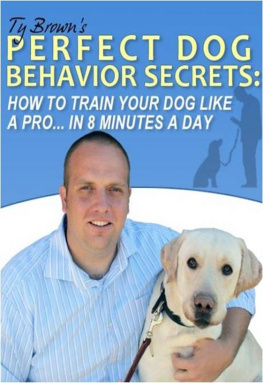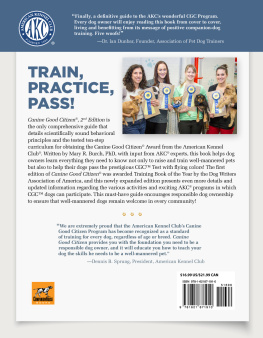
2nd Edition

Kevin Michalowski
2006 Kevin Michalowski
Published by

700 East State Street lola, Wl 54990-0001
715-445-2214 888-457-2873
Our toll-free number to place an order or obtain
a free catalog is (800) 258-0929.
All rights reserved. No portion of this publication may be reproduced
or transmitted in any form or by any means, electronic or mechanical,
including photocopy, recording, or any information storage and retrieval
system, without permission in writing from the publisher, except by a
reviewer who may quote brief passages in a critical article or review to
be printed in a magazine or newspaper, or electronically transmitted on
radio, television, or the Internet.
Library of Congress Catalog Number: 2005901826
ISBN: 0-89689-271-9
eISBN: 978-0-89689-271-2
Designed by Kara Grundman
Printed in the United States of America
Dedication
To my boys, Adam and Ethan, who would have me buy every dog in the world and gladly help me care for them all.
Acknowledgments
This book wouldnt have gotten done without the prodding and sacrifices of my wife, Jackie. Thank you, my dear. Now you should have time to go riding.
Thanks also to Steve, Dan, Tracy, Sandi, Dean, M.D. and Julie, and everyone who put up with me as I used their dogs for photos.
Special thanks to Kellie at Cabelas and everyone at Doskocil for providing good, clean products to be photographed. Dog owners everywhere know that nothing stays clean for long, and the good looking photos were really not my doing.
Kevin Howard, PR man extraordinaire, has helped me every step of the way, getting me in touch with Bob West and Dr. Arliegh Reynolds from Purina, whose knowledge of canine nutrition is second to none.
And let us not forget Echo, Oscar and Lucky, my wonderfully willing yellow Labradors, who put up with all sorts of indignity to show that they really did respond well to 15 minutes of training every day.
Him and Her
No, Im not referring to the beagles owned by former U.S. President Lyndon Johnson; Im talking about the masculine and feminine pronouns used throughout this book. I believe dog ownership is a very personal thing and really didnt want to go gender-neutral through the entire book. So, bear with me as you see pretty much random changes between him and her as I make reference to dogs in training.
I have no personal preference between male or female dogs. I like them all. I also know that you readers will be training dogs of both sexes, so I tried to alternate, just to keep everyone happy. Youll get the idea.

Im ready. Give me a command.
The Order of Things
Introduction
What does it take to get a great dog? Not as much as youd think.
Have you ever seen a dog tugging at a leash, seeming to drag his owner around the block on the evening walk? Have you watched someones playful pet jumping around, knocking over children as it completely ignores all who try to calm the animal? Or have you ever called a dog until you are red in the face and so completely frustrated that you wondered why you ever even thought to give food and shelter to such an ignorant beast? Most of these cases end with someone finally getting hold of the dog and sheepishly saying, He just needs some training. I wish I had more time.
But how much time can you afford to devote? After all, youre busy. With jobs, kids, car repairs and home maintenance, and the never ending, ever-growing list of things that make demands on your time, do you really have time to train a dog?
Yes, you do! And you can do it in just about 15 minutes a day. Its true, 15 minutes a day is all it takes to train your dog. And you will be amazed at the results. Thats because all dogs, young or old, registered show champion or refugee from the pound, have the capacity to learn. What makes it even easier is that most dogs want nothing more than to please their masters. So, if you want a great dog, read the first few pages of this book, gather up the few things youll need and go get your dog. Before long, those days of yelling, hollering and questioning the dogs lineage and your good judgment will be gone forever. In just a short time people will begin to say, What a great dog. Where did you find the time?
Who knew that you had it all along? You just needed to know how to use it.
Kevin Michalowski
August 2005
A Word About Commands Once
To train any dog, you will use commands. Put simply, commands are how we humans communicate with our dogs. Throughout this book Ill make reference to you issuing commands. Just about every chapter includes some sort of command. You need to think in the terms of giving orders. We should not be asking, begging or pleading with a dog. We should be telling the dog what to do and the dog should obey.
Yet everybody knows communication is never really that simple. Non-verbal clues, body language and voice inflection all play a huge part in how we communicate with other people, and especially with our dogs. Most communication between canines is silent. When the dominant dog of a pack wants to be the first to eat, the point is made without much noise. If the subordinate dog feels defiant, an escalation occurs until one animal backs down. If that doesnt happen, some fur could fly. But actual fights are rare. Theres usually more posturing than there is real combat. When dealing with our canine friends, our commands should be direct, consistent and given clearly either by voice or by whistle. They should also be given once and only once, and they should be obeyed. After all, they are commands, not requests.
But how do we get to that point; that wonderful place where we give a command once, and thats all that we need to say? Well, you dont get there. You start there. From your earliest training sessions, you should give your command once, then make sure the dog complies. This, of course, is easier said than done. Thats because its human nature to want to repeat ourselves if we feel we are not heard. Its also true that when we start repeating ourselves, we also tend to increase the volume, hoping that what we have to say will eventually inspire the correct actions. If you have kids, you understand Bill Cosbys wonderful line, Kids dont listen. So you repeat yourself until you end up sounding like a tobacco auctioneer, Sit down. Sit down. Sit. Sit! Sit! Sit sit, down!
If you do something similar with your dog, all you are teaching that animal is that it doesnt have to respond on the first command. If the dog has even the slightest bit of a defiant streak in his personality, you can bet it will appear if you start to repeat your commands. Repeated commands teach a dog that it has only to respond on the fourth or fifth command, if it wants to respond at all. By repeating your commands, you are not advancing to the next level of dominance the way an alpha dog would in a wild pack. You need to up the stakes and do it right away. The two keys to nipping this situation in the bud are control and consistency.
Start with control. All early training, and any remedial training, must be done on the lead or a long check cord. This gives you total control and the ability to provide instant corrective action if your first command is greeted with a less than enthusiastic response. For instance, if the command sit is given and the dog does not immediately respond, you can pull up on the short lead, push down on the animals butt and force compliance. This makes you the dominant one. without the lead, you are just hoping the dog will respond. As a rule, use the lead until your dog complies perfectly every time you issue the command, then use it for another three weeks to a month.
Next page













